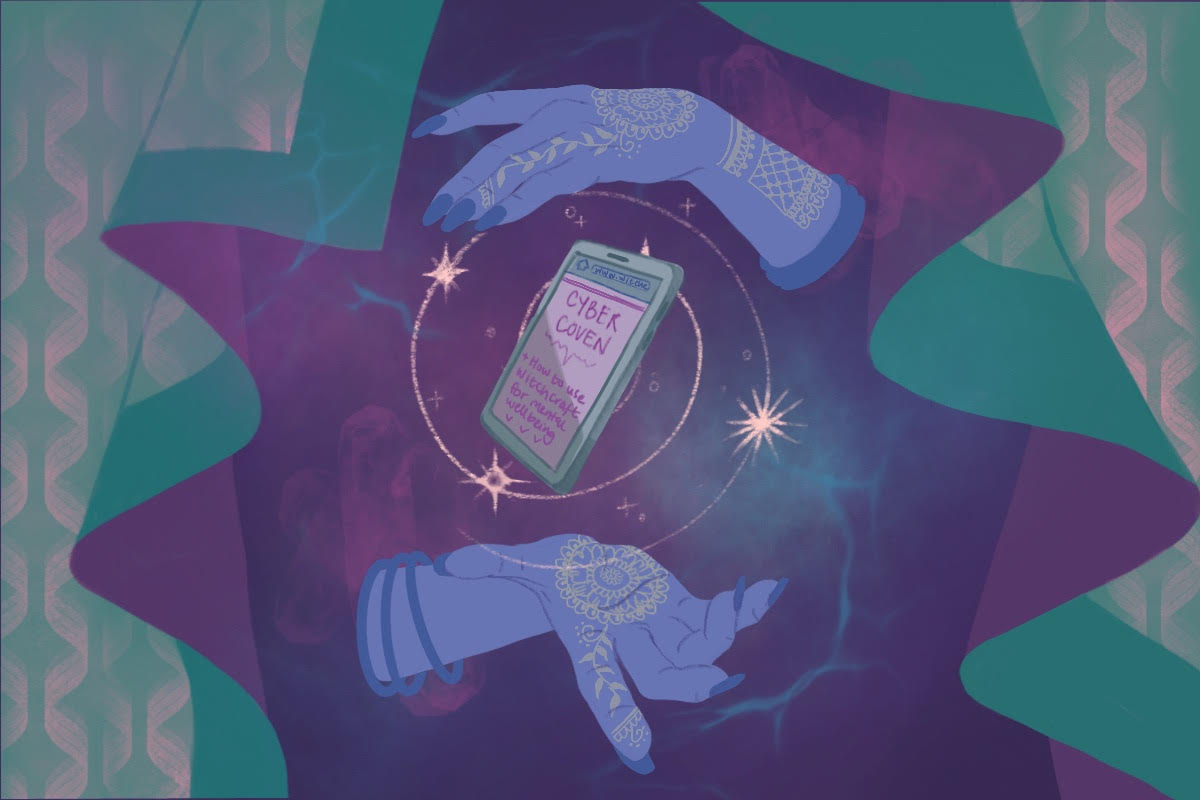Why young people in India are taking to witchcraft to preserve their mental health
As civil liberties come under increased threat, marginalised young people are taking to witchcraft to regain autonomy over their lives.
Snigdha Bansal
05 Aug 2021

Illustration by Ragavee Balendran
Across the globe, young people are grappling with the inequality they’ve inherited from the generations that came before them. The ever-growing economic, political and social turmoil has had detrimental effects on some of their mental health and their ability to visualise a future for themselves. And the pandemic has only made their prospects seem bleaker.
Young people in India have been feeling these effects more than ever before, with years of growing political unrest culminating with the government’s mishandling of the pandemic.
In 2019, several students and activists protesting against a proposed Islamophobic law were beaten, harassed and arrested by the police. Subsequently, queer and trans activists were targeted for raising dissenting slogans at a Pride march in early 2020. Political turmoil in the country reached its peak during the second wave of the COVID-19 pandemic in the spring of this year, with the country reporting close to 400,000 daily new cases in May.
As arrests, detentions, and other negative consequences for speaking out against injustices increase, young people are being stripped of their autonomy a little more with each passing day. In a last resort to take back their independence and drive change in chaotic times, some young Indians are channelling their energy into performing healing rituals and manifesting better mental health for themselves and for their country.
Although India is known as the home of many types of spirituality, witchcraft (or the suspicion that you dabble in it) can still have disastrous consequences, including being lynched and burned to death. In June 2020, after popular Bollywood actor Sushant Singh Rajput died by suicide after his girlfriend was subject to a nationwide witchhunt after being accused of practising black magic. The vitriolic public reaction to Rajput’s death also signified rising intolerance in India, where everyday acts like consuming cannabis, as Chakraborty is alleged to have done, are condemned both by traditional mainstream media and on social media.
“We aren’t going to try to hex the people in power who spread hate, we can simply protect ourselves and use our magic to secure a sense of justice”
Rishi Raj
As the government ignores the suffering of its people while simultaneously curbing civil liberties, young Indians are taking matters into their own hands — and for many, that means turning to witchcraft.
For 20-year-old Rishi Raj, who is based in Noida, Uttar Pradesh, adopting their own spiritual practice has helped emancipate them from the oppressive claws of patriarchy and religion and reclaim their minority identity as a non-binary person with a caste identity that has been historically oppressed in India. Rishi has an open practice — one that doesn’t subscribe to a specific school and is developed by the witch themselves. They say such witchcraft has historically been a tool of the marginalised to gain autonomy in a world that actively seeks to disenfranchise them.
“If you look at formalised religions, it takes a formal initiation for someone to be able to practise them. However, in the caste structure of India, Dalit, Bahujan and Adivasi people have been barred from practising these religions, and even killed for entering temples,” they say. “This has driven many of us to devise our own inclusive spiritual practices.”
Since TikTok was banned in India in June 2020, Rishi has taken to Instagram to talk about their practice, what it entails and how it has helped them navigate these difficult times for the benefit of their 16,000 followers. They have also been able to help more than 70 young people gain a deeper understanding of witchcraft and develop their own practice. While Raj attributes this sudden interest to young people’s attempts to “gain more control over their own lives” under India’s current political and social system, this phenomenon is not unique to India alone
“Witchcraft is not an aesthetic, it has always been political”
Astha Aggerwal
“Whenever there are events that really shake the foundations of society, people absolutely turn towards the occult,” witch and author Pam Grossman told The Atlantic. Witchcraft also rose in popularity after Donald Trump’s election, led by an alliance called the Magic Resistance, wherein magical practitioners cast spells to protect reproductive rights and curb Trump’s presidential powers.
Nayanika Guha, 28, lives in Ladakh, where she studies a programme focused on entrepreneurship and growth while preserving the cultural heritage of the disputed region. She started dabbling in witchcraft with two of her friends when the lockdown first started. “I wasn’t happy with the political system, or with how people were being treated in the country. On top of that, a lot of people around me were falling sick, and getting COVID,” she says.
Having always made decisions based on her intuition, she felt this was a natural progression for her. “I thought to myself, ‘Let me try doing a healing ritual and that’s where it started. Along with my friends, it became a weekly ceremony. We’d pick an issue we wanted to address and meditate on that.”
Over time, her practice has allowed her more agency over her mental health. “Instead of wallowing and endlessly worrying about the state of the world, I can now put out certain energies and thoughts into the world and have them be reflected back to me.”
In a country where young people constantly feel like they’re being stripped of rights, witchcraft has become a way of securing small victories, like dealing with the loss of a loved one to the pandemic. These practices remain highly personal, since contrary to popular belief, the aim of their witchcraft is not to hurt anyone but to find practices that help drive positive changes for you.
“We aren’t going to try to hex the people in power who spread hate, we can simply protect ourselves and use our magic to secure a sense of justice,” says Rishi.
Although the people Rishi has helped are being driven to these practices because of the grave state of affairs, witchcraft has often been co-opted as an aesthetic including in the global North and increasingly, by the rich and elite in India, with many using it as an excuse to sell overpriced crystals online and hex the moon. New Delhi-based tarot card reader and witch Astha Aggerwal, who goes by the name Esoteric Rani, thinks this behaviour comes from a position of extreme privilege.
“Dalit, Bahujan and Adivasi people have been barred from practising these religions, and even killed for entering temples. This has driven many of us to devise our own inclusive spiritual practices”
Rishi Raj
“When people get into witchcraft for the aesthetic, and post quotes like ‘We are the daughters of the witches you couldn’t burn’, they probably have no idea of the marginalised women who are being killed even today over suspicion of them being witches. Witchcraft is not an aesthetic, it has always been political,” she says. In recent times, Astha has seen an upsurge in the number of people wanting to avail of her tarot reading services and to learn the skill themselves.
A few bad experiences have made Astha cautious about who gets access to her practice and who doesn’t. She recalls the times people have been mistrustful or hostile simply at the sight of her tarot deck. On many occasions, she has been asked to leave cafes and other establishments.
But despite the potentially negative reactions from others, witches like Rishi believe their practice also equips them with the skills to deal with such comments. As right-wing trolls are emboldened by the state’s silent support, queer and non-binary youth have been flooded with merciless trolling and bullying both on social media and in real life, simply for trying to be themselves. When they couldn’t handle the incessant abuse anymore, Rishi resorted to the only technique they knew — a ritual.
“I’d created a doll that was a false image of me, which would absorb all the negativity that came my way. When it reached its saturation point and started to radiate negativity, I burned it and cast some protection on myself. Since then, it has been crickets,” they say.
Both Rishi and Astha are quick to point out that while they’ve been able to preserve their mental health and deal with hardships through witchcraft, it is not a substitute for therapy. “If we lived in a simpler world, perhaps we would be able to protect ourselves with magic. But the world we live in is complex, with issues of discrimination and poverty and so this is simply one of the tools that we can use,” says Astha.
In a society where organised religions are seeking to take complete control of what you can do, eat, and who you can love, witchcraft is allowing young people in India, marginalised by caste, gender and sexuality, to exercise freedom in their own small ways. And when the present is marred by constant deterioration and the future seems bleak, perhaps that’s all that matters.





